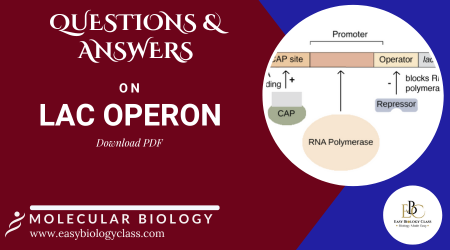The lac operon is a well-studied gene regulatory system in Escherichia coli (E. coli) that controls the metabolism of lactose. It consists of structural genes, a promoter, an operator, and a regulatory gene. The operon is activated in the presence of lactose and repressed when lactose is absent. It serves as a model system for understanding transcriptional regulation in prokaryotes. The lac operon is crucial for studying gene regulation mechanisms such as induction and repression. This article is on lac operon questions and answers. You can download the article as PDF from the link given below the post.
Molecular Biology Notes | Molecular Biology PPTs | Molecular Biology MCQs
1. What is the structure of the lac operon?
The lac operon is composed of three structural genes: lacZ, lacY, and lacA. The lacZ gene encodes β-galactosidase, which breaks down lactose into glucose and galactose. The lacY gene encodes lactose permease, a protein that facilitates lactose entry into the cell. The lacA gene encodes thiogalactoside transacetylase, which is less crucial for lactose metabolism. The operon also includes a promoter, which initiates transcription, and an operator, which is the binding site for the lac repressor. The lacI gene, located upstream, encodes the lac repressor protein. These elements work together to regulate lactose metabolism in response to environmental conditions.
2. How does the lac operon function in the absence of lactose?
In the absence of lactose, the lac repressor protein binds to the operator region of the lac operon. This binding prevents RNA polymerase from attaching to the promoter and transcribing the structural genes. As a result, the enzymes needed for lactose metabolism, such as β-galactosidase and permease, are not produced. The repressor’s binding creates a physical barrier that blocks the transcriptional machinery. This ensures that the cell does not waste energy and resources producing enzymes when lactose is not available. The operon remains in this repressed state until lactose or an inducer is present. This regulation is an example of negative control of gene expression.
3. What role does allolactose play in the regulation of the lac operon?
Allolactose acts as an inducer of the lac operon. When lactose is available in the environment, a small amount is converted into allolactose by β-galactosidase. Allolactose binds to the lac repressor protein, causing a conformational change that reduces the repressor’s affinity for the operator. This change allows RNA polymerase to access the promoter and initiate transcription of the lac genes. As a result, enzymes like β-galactosidase and permease are synthesized, enabling the cell to metabolize lactose. Allolactose thus plays a critical role in switching the operon from a repressed to an active state. This mechanism allows the cell to respond efficiently to changes in lactose availability.
4. How does glucose affect the activity of the lac operon?
Glucose exerts catabolite repression on the lac operon, which means it suppresses the expression of the operon even when lactose is present. This occurs through the cAMP-CRP complex, where the cyclic AMP (cAMP) levels decrease when glucose is abundant. Low cAMP levels result in reduced binding of the cAMP-CRP complex to the promoter of the lac operon, thus decreasing the efficiency of transcription. When glucose levels are low, cAMP levels increase, allowing the cAMP-CRP complex to bind to the promoter and enhance transcription. This mechanism ensures that E. coli preferentially uses glucose over lactose due to its simpler metabolism. The dual regulation by glucose and lactose allows the bacteria to optimize energy use. This process is known as catabolite repression and is a key example of positive control in gene regulation.
5. What is the role of the cAMP-CRP complex in the regulation of the lac operon?
The cAMP-CRP complex functions as an activator of the lac operon under low glucose conditions. When glucose levels are low, cyclic AMP (cAMP) accumulates and binds to the cAMP receptor protein (CRP). This cAMP-CRP complex then binds to a site near the promoter of the lac operon, enhancing the binding affinity of RNA polymerase. This activation increases the transcription of the lac genes, facilitating lactose metabolism. The cAMP-CRP complex ensures that the operon is only highly active when glucose is scarce and lactose is present. This allows E. coli to efficiently adapt to changing environmental conditions. The cAMP-CRP complex is an example of positive control in operon regulation.
6. How does the lac repressor protein control transcription of the lac operon?
The lac repressor protein, encoded by the lacI gene, regulates transcription by binding to the operator sequence of the lac operon. When bound, it physically obstructs RNA polymerase from transcribing the lacZ, lacY, and lacA genes. This repression occurs in the absence of lactose or an inducer. The repressor protein can detach from the operator when it binds to allolactose, an inducer that alters its conformation. This detachment allows RNA polymerase to access the promoter and transcribe the operon’s genes. The lac repressor thus functions as a switch, turning the operon on or off based on lactose availability. This form of regulation is crucial for conserving cellular resources.

7. What is the significance of the operator region in the lac operon?
The operator region is a DNA sequence in the lac operon that serves as the binding site for the lac repressor protein. It is located between the promoter and the structural genes of the operon. When the repressor binds to the operator, it prevents RNA polymerase from initiating transcription of the lac genes. This makes the operator region a key element in regulating the expression of the operon. The ability of the repressor to bind or release from the operator depends on the presence of inducers like allolactose. Mutations in the operator can disrupt this binding, leading to constitutive expression of the lac genes. The operator’s role is crucial in maintaining the precise control of lactose metabolism.
8. What happens to the lac operon when both lactose and glucose are present?
When both lactose and glucose are present, the lac operon is only partially active due to catabolite repression by glucose. Although allolactose can bind to the lac repressor and deactivate it, the presence of glucose lowers cAMP levels. This results in reduced binding of the cAMP-CRP complex to the promoter, leading to a lower rate of transcription. Consequently, the operon is not fully induced, and the production of enzymes for lactose metabolism is decreased. E. coli prioritizes glucose metabolism because it is more energetically efficient than lactose metabolism. Only when glucose levels drop does cAMP increase, leading to full activation of the lac operon. This regulatory mechanism enables the bacteria to optimize energy utilization.
9. What is a constitutive mutation in the lac operon, and how does it affect gene expression?
A constitutive mutation in the lac operon results in continuous expression of the structural genes regardless of lactose presence. This type of mutation often occurs in the operator region, preventing the lac repressor from binding effectively. As a result, RNA polymerase can access the promoter and transcribe the lac genes without regulation. Constitutive expression can also arise from mutations in the lacI gene that prevent the production of a functional repressor protein. Such mutations disrupt the normal inducible control of the operon, leading to unregulated enzyme synthesis. This can result in an unnecessary expenditure of cellular energy in the absence of lactose. Constitutive mutations are important for understanding the mechanisms of gene regulation and repressor-operator interactions.
10. How has the study of the lac operon advanced our understanding of gene regulation in prokaryotes?
The lac operon has provided a fundamental model for understanding the principles of gene regulation in prokaryotes. It has illustrated how genes can be turned on or off in response to environmental signals, such as the presence or absence of a specific nutrient. The operon concept has been applied to understand other regulatory systems in bacteria, such as the trp operon. It has also highlighted the roles of repressors, inducers, and activator proteins in controlling transcription. Additionally, the study of the lac operon has shed light on mechanisms like negative and positive control, as seen with the repressor and the cAMP-CRP complex. It has served as a foundation for genetic engineering and synthetic biology applications. The lac operon remains a key example of how prokaryotic cells adapt to their environment at the molecular level.
<<< Back to Molecular Biology Notes
I hope you found this article on Lac Operon Questions and Answers is informative and beneficial. Your feedback and comments would be greatly appreciated. Whether you have suggestions, questions, or thoughts to share, I would be delighted to hear from you. Engaging with your comments helps me continue to produce high-quality content in Biology. Please feel free to leave a comment below. Thank you for your support.
Regards: Admin, EasyBiologyClass
| You may also like NOTES in... | ||
|---|---|---|
| BOTANY | BIOCHEMISTRY | MOL. BIOLOGY |
| ZOOLOGY | MICROBIOLOGY | BIOSTATISTICS |
| ECOLOGY | IMMUNOLOGY | BIOTECHNOLOGY |
| GENETICS | EMBRYOLOGY | PHYSIOLOGY |
| EVOLUTION | BIOPHYSICS | BIOINFORMATICS |
Want to read offline? download full PDF here: Lac Operon Questions And Answers PDF
